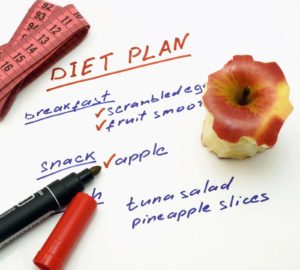
An Example Of A Successful No-Diet Weight Loss Journey.
A 45-year-old woman complains that she has gradually put on 12 pounds over the past year. In the last month, she’s faced a stressful work deadline and added another 4 pounds to her frame.
This individual’s goal is to lose the 16 pounds she has gained. Since her weight has been gradually increasing, she knows that she is consuming more calories than she is burning, especially with her sedentary job. She decides that losing weight at a rate of 1 pound per week, equal to a deficit of about 3,500 calories, or cutting 500 calories per day, would be acceptable and would allow her to reach her goal in about four months.
She decides to make some changes that will allow her to cut back an average of 250 calories per day.
- Skipping a large glass of sweetened iced tea will save about 200 calories.
- Substituting mineral water for the cola she regularly drinks during meetings can save another 150 calories.
- Foregoing her morning muffin snack, or eating only half a muffin, can also save 250 calories or more.
To reach her goal of a 500-calorie-per-day savings, she adds some exercise.
- Getting up early for a 20-minute walk before work and adding a 10-minute walk during her lunch break add up to a half hour of walking per day, which can burn about 200 calories.
- On weekends, she plans to walk for 60 minutes one day and spend one hour gardening the next day for even greater calorie burning. If walking for 60 minutes is too much, two 30-minute walks one day would burn the same number of calories.
- Twice per week she plans to stop at the gym on the way home from work, even if only for a half hour of stationary cycling or swimming, each burning up to 250 calories.
By making just some of the dietary cutbacks mentioned and starting some moderate exercise, this individual can easily “save” the 3,500 calories per week needed for a 1-pound weight loss, leading to a healthy rate of weight loss without extreme denial or deprivation. Furthermore, her changes in diet and lifestyle are small and gradual, modifications that she can maintain over time.

The No-Diet Approach To Weight Control.
By adopting sensible eating habits and practicing portion control, you can eat nutritious foods so that you take in as many calories as you need to maintain your health and well-being at your ideal weight. Often, weight loss occurs on its own simply when you start making better food choices, such as avoiding the following:
- Processed foods.
- Sugar-laden foods.
- White bread and pasta (substitute whole-grain varieties instead).
- Foods with a high percentage of calories from fat, such as many fast foods.
- Alcohol.
While nothing is absolutely forbidden, when you do succumb to temptation, keep the portion size small and add a bit more exercise to your daily workout.
By replacing some unwise food choices with healthy ones, you’ll be cutting back on calories. If you add some moderate physical activity, you have the perfect plan for losing weight without the need for special or inconvenient (and often expensive) diet plans. It’s also important to follow healthy eating guidelines in general, even after you have lost the weight. This should include sufficient amounts of protein, vitamins, and minerals with limited amounts of fat and sugar.

How Fast Should You Expect To Lose Weight?
Most fitness and nutrition experts agree that the right way to lose weight is to aim for a safe, healthy rate of weight loss of one to 1½ pounds per week, short-term dramatic weight loss is rarely healthy or sustainable over time. Modification of eating habits along with regular exercise is the most effective way to lose weight over the long term. It is also the ideal way to ensure that the weight stays off.
Starvation or extreme diets may result in rapid weight loss, but such quick weight loss can be unsafe and is almost impossible to maintain for most people. When food intake is severely restricted, below approximately 1,200 calories per day, the body begins to adapt to this state of poor nutrition by reducing its metabolic rate, potentially making it even more difficult to lose weight. This also happens when dieters engage in fasting or skipping meals. It is also possible to experience hunger pangs, bouts of hypoglycemia, headaches, and mood changes from overly stringent dieting. These health symptoms can result in binge eating and weight gain. Since a highly restrictive diet is almost impossible to maintain for a long time, people who attempt to starve themselves thin often start to gain weight again when they stop dieting and resume their former eating habits.

How Do You Lose Weight?
The best approach for weight loss is reducing the number of calories you eat while increasing the number of calories you burn through physical activity. To lose one pound you need an expenditure of approximately 3,500 calories. You can achieve this either by cutting back on your food consumption, by increasing physical activity, or ideally, by doing both.
For example, if you consume 500 extra calories per day for one week without changing your activity level, you will gain one pound in weight, seven days multiplied by 500 calories equals 3,500 calories, or the number of calories resulting in a one pound weight gain. Likewise, if you eat 500 fewer calories each day for a week or burn 500 calories per day through exercise for one week, you will lose one pound.
Any fitness activities you do throughout the day are added to your BMR (basal metabolic rate) to determine the total number of calories you burn each day. For example, a 170-pound person who spends 45 minutes walking briskly will burn about 300 calories. The same time spent on housecleaning burns about 200 calories, and mowing the lawn for 45 minutes consumes around 275 calories.
